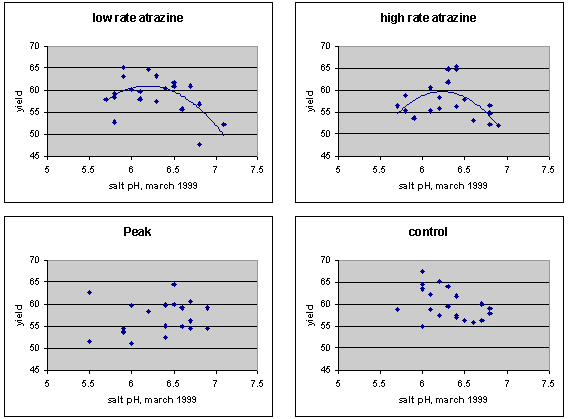Fertilizer and Ag Lime Grants
Title: No-till lime management and soil pH effects on herbicide carryover
Principal Investigators: Peter Scharf, Bill Johnson, and Jim
Wait
Agronomy Department, University of Missouri
Objective: Evaluate yield loss due to carryover of
pH-sensitive herbicides at different soil pH levels in a no-till
soybean-corn rotation.
Methods:
- Experiments conducted at Bradford Farm east of Columbia
- No-till soybean-corn rotation
- Five treatments were applied in December 1998 to set up a range
of soil pH values:
- 2 tons lime/ac
- 1 ton lime/ac
- untreated
- 1 ton iron sulfate/ac
- 2 tons iron sulfate/ac
- Salt pH values to a one-inch depth were measured for all plots
in March 1999 and ranged from 5.5 to 7.1
- The experimental area was divided with corn grown on half the
plot and soybean grown on the other half in 1999.
- Three pH-sensitive herbicide treatments were applied to each
crop, as shown in Table 1, in April or May 1999.
- Roundup Ready crops were grown and weeds were controlled with
postemergence Roundup applications so that there was no variation in
weed control between plots.
- In 2000, the crops were rotated such that corn was grown on the
soybean plots and vice versa to evaluate carryover of corn
herbicides to soybean and soybean herbicide to corn. No herbicide
treatments were applied in 2000 except for Roundup. Yield and
moisture were measured at harvest.
Table 1. Herbicide Treatments applied in 1999.
|
Corn | Soybean |
|
Herbicide | Rate (lb/ac) | Herbicide | Rate (lb/ac) |
|
Atrazine | 1.25 | Pursuit | 0.063 |
|
Atrazine | 2.5 | Scepter | 0.125 |
|
Peak | 0.018 | Classic | 0.04 |
|
Untreated | | Untreated | |
Results for 2000:
- 2000 corn yields were not affected by pH or herbicide treatments
- 2000 soybean yields were affected by both pH and herbicide
treatments
- Yields were slightly lower for plots that had been
treated with Peak or the high rate of atrazine in 1999 (Table 2)
- Yields were slightly lower for limed plots than for
untreated or acid-treated plots (Table 3); this effect seemed to
occur mainly in plots receiving atrazine (Figure 1)
- Plots receiving either rate of atrazine in 1999
yielded higher at medium pH levels than at low or high pH (Figure 1)
- Plots receiving Peak in 1999 yielded lower than
control plots across all pH levels (Figure 1)
- No visible symptoms of herbicide damage were
associated with these yield losses
Table 2. Effects of corn herbicide carryover on soybean yield
averaged over soil pH.
|
Herbicide lb/a | Yield bu/a |
|
Atrazine 1.25 | 59 |
|
Atrazine 2.5 | 57 |
|
Peak 0.018 | 57 |
|
Untreated | 60 |
|
LSD (0.05) | 2 |
Table 3. Effect of lime or acid treatments on soybean yield averaged
over herbicide treatments.
|
pH treatments | Yield bu/a |
|
2 tons lime | 57 |
|
1 ton lime | 57 |
|
untreated | 60 |
|
1 ton FeSO4 | 58 |
|
2 tons FeSO4 | 60 |
|
LSD (0.05) | 2 |
Figure 1. 2000 no-till soybean yields as a function of salt pH of
the top inch of soil in March 1999 for each of the four corn
herbicide treatments applied in 1999. Statistically significant
trends were seen when atrazine had been applied in 1999, but not for
the Peak or untreated plots.

Conclusions:
The 1999-2000 season was favorable for herbicide carryover due to
drought from July 1999 to May 2000. Herbicide breakdown is slower
under dry soil conditions for many herbicides (though faster for
some herbicides).
Soybean yield reductions were seen in 2000 as a result of corn
herbicides applied in 1999. Peak lowered yield by 3 bu/acre
regardless of soil pH or liming. Atrazine lowered yield mainly at
high pH values (salt pH above 6.5, which roughly equals water pH
above 7.0). Avoiding over-liming appears to be important for
soybean profitability when atrazine is used in a no-till
soybean-corn rotation. Small, frequent lime applications may be
appropriate.
Corn yields in 2000 were not affected by soybean herbicides applied
in 1999.
Preliminary Observations for 2001:
|